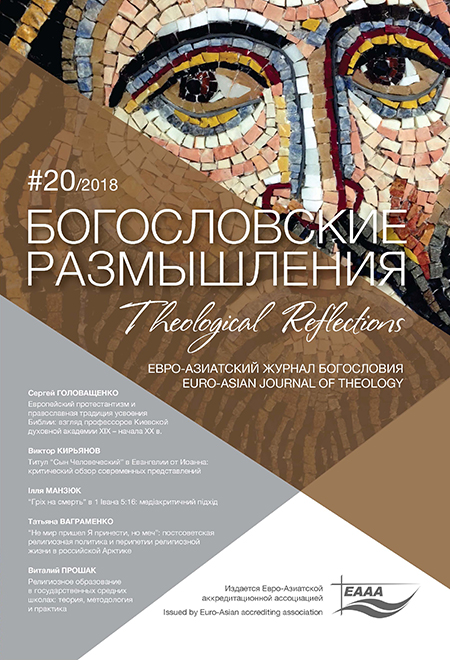‘Sin unto Death’ In 1 John 5:16: A Media Critical Approach
DOI:
https://doi.org/10.29357/issn.2521-179X.2018.20.5Keywords:
Orality, Oral tradition, New Testament, 1 John, “Sin unto death”Abstract
Recent developments in the field of biblical media criticism, the study of the function and dynamics of various mediums of communication, offer potential for advancing our understanding of the referent of ‘sin unto death’ in 1 John 5:16-17. Indeed, precise interpretation has proven to be elusive for both ancient and modern scholars as questions abound. What type of death is in view? Which sin does the author have in mind? Can a true believer commit “sin unto death?” As it stands there is no scholarly consensus on these issues. To be sure, a recent commentary surveyed at least 20(!) possible meanings.
This paper will propose a way past the stalemate by considering the oral dynamics of the text. It will apply John Miles Foley’s (Immanent Art, 1991; Singer of Tales In Performance, 1995) concept of “word power” to the passage, following Rafael Rodriguez’s adaptation of the method to NT studies (Structuring Early Christian Memory, 2010). I will argue that the apostasy of the false brethren from among the audience is the most likely referent, given the interpretation’s ability to best incorporate the oral dynamics of the text and it’s contextualizing tradition.
References
- Akin, Daniel L. 1, 2, 3 John. Vol. 38. The New American Commentary. Nashville: Broadman & Holman Publishers, 2001.
- Brooke, A. E. A Critical and Exegetical Commentary on the Johannine Epistles. Edinburgh: T. & T. Clark Ltd., 1912.
- Brown, Raymond E. The Epistles of John. The Anchor Bible. New York: Doubleday and Company Inc., 1982.
- Bruce, F. F. The Epistles of John. New Jersey: Fleming H. Revell Company, 1970.
- Bultmann, Rudolf. The Johannine Epistles. Hermeneia. Trans. by R. P. O’Hara, L. C. McGaughy, and R. W. Funk. Philadelphia: Fortress Press, 1973.
- Culley, Robert C. “Tradition and Biblical Studies.” Oral Tradition 1, no. 1 (1986): 30-65.
- Davis, Casey W. “Hebrews 6:4-6 From An Oral Critical Perspective.” Journal of the Evangelical Theological Society 51, no. 4 (December 2008): 753-67.
- Dunn, James D.G. “Altering the Default Setting.” In The Oral Gospel Tradition. Grand Rapids: Eerdmans, 2013: 41-79.
- Evans, Craig A. Jesus and the Remains of His Day. Peabody: Hendrickson, 2015.
- Eve, Eric. Behind the Gospels: Understanding the Oral Tradition. Minneapolis: Fortress, 2014.
- Foley, John Miles. The Theory of Oral Composition. Indianapolis: Indiana University Press, 1988.
- Foley, John Miles. The Singer of Tales in Performance. Indianapolis: Indiana University Press, 1995.
- Hezser, Catherine. Jewish Literacy in Roman Palestine. Texts and Studies in Ancient Judaism 81. Tübigen: Mohr Siebeck, 2001.
- Harris, W. Hall III. 1, 2, 3 John: Comfort and Counsel for a Church in Crisis. Dallas: Biblical Studies Press, 2003.
- Harris, W. Hall III. “A Theology of John’s Writings.” In A Biblical Theology of the New Testament, ed. Roy B. Zuck and Darrell L. Bock, 167-242. Chicago: Moody, 1994.
- Harvey, John D. “Orality and Its Implications for Biblical Studies: Recapturing an Ancient Paradigm.” Journal of the Evangelical Theological Society 45, no. 4 (March 2002): 99-109.
- Kaiser, Walter C. Toward Rediscovering the Old Testament. Grand Rapids: Zondervan, 1987.
- Kostenberger, Andreas J., L. Scott Kellum, and Charles L. Quarles. The Cradle, The Cross, and the Crown: An Introduction to the New Testament. Nashville: B&H Publishing, 2009.
- Kruse, Colin G. The Letters of John. The Pillar New Testament Commentary. Grand Rapids: Eerdmans, 2000.
- Marshall, I. Howard. New Testament Theology: Many Witnesses, One Gospel. Downers Grove: InterVarsity Press, 2004.
- Ong, Walter J. Orality and Literacy. 2nd ed. New York: Routledge, 2002.
- Riesner, Rainer. “The Orality and Memory Hypothesis,” in The Synoptic Problem: Four Views, ed. by Stanley Porter and Brian Dyer. Grand Rapids: Baker Academic, 2016: 89-111.
- Reynolds, S. M. “The Sin unto Death and Prayers for the Dead.” RefR 20 (1973): 130–39.
- Rodriguez, Rafael. Structuring Early Christian Memory: Jesus in Tradition, Performance, and Text. New York: Bloomsbury T&T Clark, 2010.
- Rodriguez, Rafael. Oral Tradition and the New Testament: A Guide for the Perplexed. Guides for the Perplexed. New York: Bloomsbury T&T Clark, 2014.
- Rosenberg, Bruce A. “The Complexity of Oral Tradition.” Oral Tradition 2, no. 1 (1987): 73-90.
- Shiner, Whitney. Proclaiming the Gospel: First Century Performance of Mark. Harrisburg: Trinity Press International, 2003.
- Smalley, Stephen S. 1, 2, 3 John. World Biblical Commentary. Nashville: Thomas Nelson, 2007.
- Smith, D. Moody. First, Second, and Third John. Interpretation. Louisville: John Knox Press, 1991.
- Westcott, Brooke Foss, ed. The Epistles of St. John: The Greek Text with Notes and Essays. 4th ed. Classic Commentaries on the Greek New Testament. London; New York: Macmillan, 1902.
- Witherington III, Ben. Letter and Homilies for Hellenized Christians. Vol. 1. Downers Grove: IVP Academic, 2006.
Downloads
Published
How to Cite
Issue
Section
License
Copyright (c) 2020 Ilya MANZYUK

This work is licensed under a Creative Commons Attribution-NonCommercial 4.0 International License.
All articles published in the Journal are distributed under a Creative Commons Attribution-NonCommercial 4.0 International License
By submitting an article for publication in Theological Reflections: Eastern European Journal of Theology the author grants the editors the right to publish the article and distribute it in electronic and print form.
The author reserves all copyrights and the right to use the materials of the article in whole or in part for educational purposes, to write his own dissertations, to prepare abstracts, conference reports, oral presentations, etc., as well as post electronic copies of articles (including the final electronic version downloaded from the journal’s official website) on non-commercial web-resources without the consent of the editorial board and founders.



